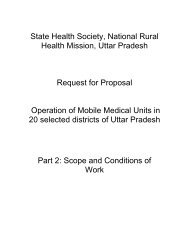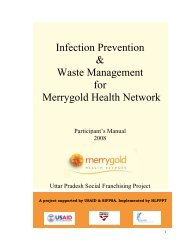Obstetrics Manual for Merrygold Hospitals - State Innovations in ...
Obstetrics Manual for Merrygold Hospitals - State Innovations in ...
Obstetrics Manual for Merrygold Hospitals - State Innovations in ...
Create successful ePaper yourself
Turn your PDF publications into a flip-book with our unique Google optimized e-Paper software.
Note: A more rapid rate of <strong>in</strong>fusion is required <strong>in</strong> the management of shock result<strong>in</strong>g<br />
from bleed<strong>in</strong>g. Aim to replace 2–3 times the estimated fluid loss.<br />
• If a peripheral ve<strong>in</strong> cannot be cannulated, per<strong>for</strong>m a venous cut down<br />
• Cont<strong>in</strong>ue to monitor vital signs (every 15 m<strong>in</strong>utes) and blood loss.<br />
• Catheterize the bladder and monitor fluid <strong>in</strong>take and ur<strong>in</strong>e output.<br />
• Give oxygen at 6–8 L per m<strong>in</strong>ute by mask or nasal prongs.<br />
Determ<strong>in</strong><strong>in</strong>g and Manag<strong>in</strong>g the Cause of Shock<br />
Determ<strong>in</strong>e the cause of shock after the woman is stabilized.<br />
A. If heavy bleed<strong>in</strong>g is suspected as the cause of shock:<br />
- Take steps simultaneously to stop bleed<strong>in</strong>g (e.g. Oxytocics, uter<strong>in</strong>e massage,<br />
bimanual compression, aortic compression, preparations <strong>for</strong> surgical<br />
<strong>in</strong>tervention);<br />
- Transfuse as soon as possible to replace blood loss ;<br />
- Determ<strong>in</strong>e the cause of bleed<strong>in</strong>g and manage:<br />
- If bleed<strong>in</strong>g occurs dur<strong>in</strong>g first 22 weeks of pregnancy,<br />
- suspect abortion, ectopic or molar pregnancy ;<br />
- If bleed<strong>in</strong>g occurs after 22 weeks or dur<strong>in</strong>g labor but be<strong>for</strong>e delivery,<br />
suspect placenta praevia, abruption placentae or ruptured uterus ;<br />
- If bleed<strong>in</strong>g occurs after childbirth, suspect ruptured uterus, uter<strong>in</strong>e atony,<br />
tears of genital tract, reta<strong>in</strong>ed placenta or placental fragments.<br />
- Reassess the woman’s condition <strong>for</strong> signs of improvement<br />
B. If <strong>in</strong>fection is suspected as the cause of shock:<br />
- Collect appropriate samples (blood, ur<strong>in</strong>e, pus) <strong>for</strong> microbial culture be<strong>for</strong>e<br />
start<strong>in</strong>g antibiotics, if facilities are available;<br />
- Give the woman a comb<strong>in</strong>ation of antibiotics to cover aerobic and anaerobic<br />
<strong>in</strong>fections and cont<strong>in</strong>ue until she is fever-free <strong>for</strong> 48 hours :<br />
- penicill<strong>in</strong> G 2 million units OR ampicill<strong>in</strong> 2 g IV every 6 hours;<br />
- PLUS Gentamic<strong>in</strong> 5 mg/kg body weight IV every 24 hours;<br />
- PLUS Metronidazole 500 mg IV every 8 hours.<br />
Do not give antibiotics by mouth to a woman <strong>in</strong> shock.<br />
C. If trauma is suspected as the cause of shock, prepare <strong>for</strong> surgical <strong>in</strong>tervention.<br />
Reassessment<br />
• Reassess the woman’s response to fluids with<strong>in</strong> 30 m<strong>in</strong>utes to determ<strong>in</strong>e if her<br />
condition is improv<strong>in</strong>g. Signs of improvement <strong>in</strong>clude:<br />
- stabiliz<strong>in</strong>g pulse (rate of 90 per m<strong>in</strong>ute or less);<br />
- <strong>in</strong>creas<strong>in</strong>g blood pressure (systolic 100 mm Hg or more);<br />
- improv<strong>in</strong>g mental status (less confusion or anxiety);<br />
- <strong>in</strong>creas<strong>in</strong>g ur<strong>in</strong>e output (30 mL per hour or more).<br />
42










